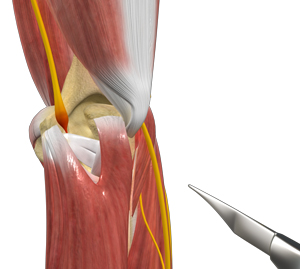
The ulnar nerve is one of the 3 main nerves in the arm that travels down from the neck through a bony protuberance inside the elbow (medial epicondyle), under the muscles of the forearm and down the hand on the side of the palm, towards the little finger. The ulnar nerve helps in controlling most of the hand muscles which carry out fine movements as well as some bigger forearm muscles which help in making a strong grip.
The ulnar nerve can be constricted in many places, which results in nerve entrapment. The compression pressure on the nerve can cause pain and numbness in various parts of the arm. Compression of the nerve occurs most commonly against the medial epicondyle and is called cubital tunnel syndrome. Ulnar nerve transposition is a surgical procedure performed to transpose or move the ulnar nerve to an appropriate position from the back of the medial epicondyle.
Indications for Ulnar Nerve Transposition
Ulnar nerve transposition is indicated to relieve the pressure placed on the compressed ulnar nerve. Conditions that may require ulnar nerve transposition include:
- Compression of the ulnar nerve caused due to injury or excessive pressure placed on the elbow.
- Ulnar nerve entrapment due to conditions like rheumatoid arthritis, or cubital tunnel syndrome.
- Failure of conservative therapy measures.
- Drawing back (clawing) of the fourth and fifth digits of your hand.
- A progressive loss of the hand’s ability to move.
Preparation before Surgery
Before undergoing the ulnar nerve transposition surgery, your doctor will carry out a complete clinical examination, and order blood tests and chest X-rays. The affected area from the neck to the fingers will be prepared for the surgery and a tourniquet (device to stop blood flow) may be applied if required.
How is the Procedure Performed?
Ulnar nerve transposition is performed under general or regional anesthesia.
Incision and nerve location: Your surgeon will make a small incision around the medial epicondyle and locate the ulnar nerve.
Transposition: Your surgeon then carefully moves the ulnar nerve from under the medial epicondyle and positions it in front of it (anterior transposition). The nerve can be placed on top of the muscle, under the skin and fat (subcutaneous transposition), under the muscle (submuscular transposition) or within the muscle (intermuscular transposition). The incision will then be sutured. The anterior transposition prevents nerve entrapment at the bony ridge and stretching of the nerve when the elbow is bent.
Post-operative Care
Following the procedure, your doctor will remove the applied tourniquet. The elbow is set with a splint at an angle of 45 degrees after subcutaneous transposition or at an angle of 90 degrees after inter-muscular transposition. The bent position of the elbow is maintained for a few weeks. Your physical therapist will suggest toning and muscle stretching exercises to restore full range of motion as well as to control pain and reduce swelling. You can resume regular activities after consulting with your doctor.
Risks and Complications
As with any surgical procedure, ulnar nerve transposition involves certain risks and complications. Some of the complications that may occur include:
- Nerve injury
- Failure to completely decompress the ulnar nerve
- Infection
- Thrombophlebitis (inflammation of veins)








